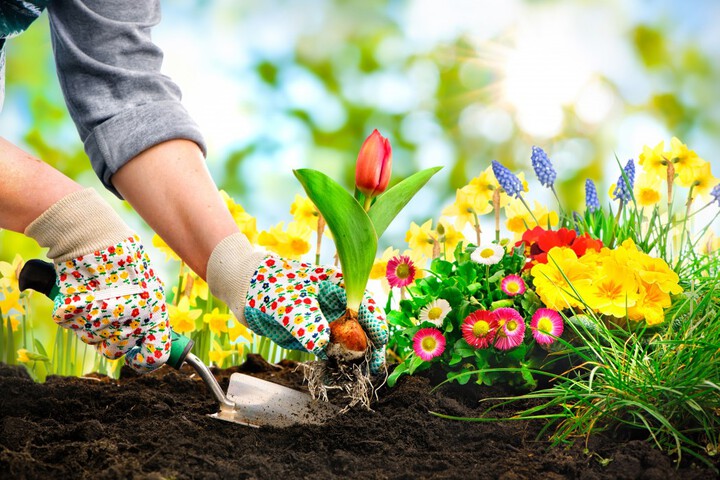Want to create a flourishing garden this summer but don’t know how to get started? Don’t worry—setting up your own personal Eden is easier than you think. With just a little bit of prep work, you can set your garden up for success.
There are so many perks to gardening: a garden beautifies your space, helps the environment, and can produce amazingly delicious fruits and veggies. On top of that, gardening is actually moderate cardiovascular exercise—though when you work on the garden, you often don’t even notice you’re exercising. It’s great for your mind, your body, and the planet. So follow these tips and get ready to have the greatest summer garden ever.

It’s easy to get carried away at the gardening centre (seeds! So many seeds!), so try to plan out the basics of what you want to grow before you go out to get your supplies. There are lots of different directions you can go: vegetables, herbs, flowers. And you can also decide if you want to plant perennials, which come back every year, saving you the trouble of planting anew. So grab your first gardening tools—a pen and paper—and get going.
Prepare your gardening area
If you’ve grown a garden before, then your gardening space might be well prepped already. However, if you’re just starting, chances are you’ll need to enrich your soil. If your soil is light brown, that’s a sign that it needs some help. Organically rich soil is usually dark brown or black. Get some good compost and/or aged mushroom soil, and add 10 to 15 centimetres onto your own soil. Then, dig the compost into the surrounding soil. This will also help loosen the ground, creating space for roots to grow.
Get planting
Read up a bit on the seeds you’re planting. Most packages will have detailed information or links to websites with more info. Some plants do well if you sow them directly into the garden, but others benefit from first being planted in containers that can be moved and brought indoors if it gets cold. If you’re overwhelmed by all the prep work and aren’t sure about growing your own plants from seed, you can get starter plants that professional have grown. This is particularly a good route for new gardeners.
Garden according to your location
No matter how good a gardener you are, some plants will struggle if they don’t live in the right sort of climate and environment. Plants have evolved to live in certain conditions, which means the best way to have a thriving garden is to choose plants that are meant to live in your region. As well, take a look at your garden space. Is it in full sun? Partially shaded? Exposed to a lot of wind? Take these things into account when choosing what you want to plant.
Next Steps:
Want to take your garden to the next level? Build raised beds
So maybe you’re feeling pretty confident about your gardening skills, but you want to have a more productive garden that you can work on with a little less back strain. Take your garden to the next level—literally. By building raised beds for your plants, you put them in easy reach so that tending your garden will be a lot easier. As well, the plants will be separated from the surrounding terrain, which means you’ll have less weeds to fend off. And you won’t have to worry about stepping on your precious plant-babies.
Create a weed barrier
If you’re struggling with weeds, you can create a barrier to block them from growing—but you have to do it before you put in your own plants. First, pull all of the unwelcome plants out by the root as much as possible. Next, lay down a layer of cardboard. Then, build your garden beds on top of the cardboard. The cardboard barrier should keep any buried weeds from getting the sunlight and nutrients they need to take over your garden.
Mulch
Another way of keeping weeds out (and moisture in) is to put mulch over your soil. Mulch can come in many forms: dead leaves, hay, wood chips, grass clippings, burlap bags, or biodegradable mats built for mulching. Basically, you spread mulch over your soil, and they keep the soil cool, stop weeds from getting in, and stop water from evaporating. If you’re using organic matter from your own lawn for mulch, let it dry out in the sun for a day before spreading it, and make sure it hasn’t been exposed to toxic pesticides or chemicals. And keep it about an inch away from your plant stems to prevent any rot issues.
Keep your aggressive plants contained
If you have a plant that tends to spread and take over the garden, take steps to restrict its movement. A good way to do this is to plant it in a large pot, then cut the bottom out and plant the whole thing, pot and all. This will prevent the plant from growing sideways but still allow its roots to lengthen straight down.
Do a little rubbernecking
Still not sure what kind of plants will thrive best in your garden? Take a stroll around your neighbourhood and check out what your neighbours are growing. If a plant seems to be growing well in their garden, chances are it will in yours too. And don’t restrict yourself to peeking over fences—strike up a conversation! Having gardening buddies is great for sharing tips, and sometimes even plants.